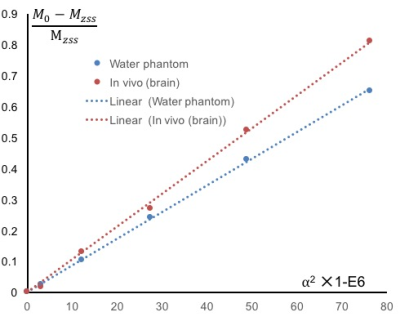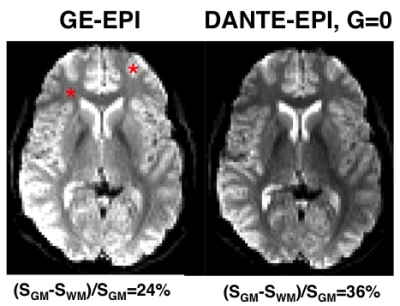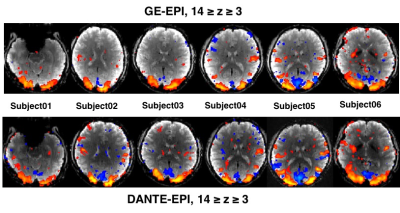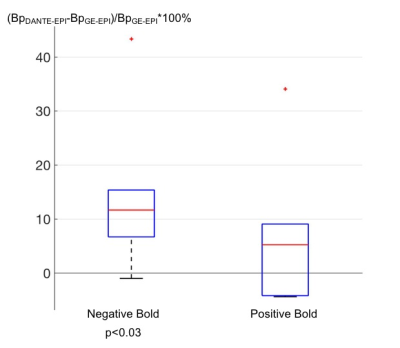4646
Enhancement of the Negative BOLD Response with DANTE-EPI1National Institute of Mental Health, National Institutes of Health, Bethesda, MD, United States, 2Nuffield Department of Clinical Neurosciences, University of Oxford, Oxford, United Kingdom
Synopsis
We derived and verified an equation for the theoretical description of longitudinal magnetization for pass- and transition-band bSSFP at steady state. In addition, we show evidence that a DANTE (b-SSFP) preparation module may be employed with an EPI readout to increase negative BOLD response by 12.8% in average (p<0.03) compared to conventional EPI (GE-EPI).
Introduction:
Previously, transverse magnetization of both pass-band and transition-band balanced steady-state free precession (bSSFP) have been demonstrated as imaging tools for BOLD measurement [1,2]. In this study, we derived an equation to theoretically study the longitudinal magnetization of pass- and transition-band of bSSFP at steady state. Due to the intrinsic T2 weighting indicated in the longitudinal magnetization equation, we hypothesize that bSSFP or delay alternating with nutation for tailored excitation (DANTE) may be used as preparation module with multislice EPI for BOLD effect enhancement.Theory and Methods:
$$\frac{M_{0}-{M_{zss}}}{M_{zss}}=\frac{2}{1-E_{2}cos\theta}(\frac{T_{1}}{T_{2}})(\tan\frac{\alpha}{2})^{2}$$
$$Equation. 1$$
The proposed
DANTE-EPI imaging sequence is shown in Fig. 1. Constant and alternating phases
of RF may be used to prepare longitudinal magnetizations as transition- and
pass-band, respectively. We first derived Eq. 1 from the Bloch equation for
longitudinal magnetization of bSSFP at steady state (Mzss) [3]. In Eq. 1, α is
the flip angle of a single RF pulse and M0 is the signal intensity when α is
equal to zero. E2 is equal to exp(-tD/T2) which is ≈1 due to tD<<T2,
where tD is the RF repetition time of bSSFP/DANTE. θ is the off-resonance. T2 weighing shown in Eq. 1, resulted from the
DANTE (or bSSFP) preparation module, may be used to increase the BOLD signal
difference on top of the T2* contrast from the EPI readout due to the
synchronized changing pattern of T2* and T2.
For verification of
the equation, a DANTE train with constant RF phase was used for preparing
transition-band longitudinal magnetization. Alternating phases of the pulses
between 0º and 180º in Fig. 1 were implemented to prepare passband longitudinal
bSSFP for BOLD detection. All scans were acquired using a 32-channel head coil
with a 3T Siemens scanner. Written informed consent was obtained from 6 healthy
volunteers (24 to 50 years). Subjects were given a small size checkerboard
stimulation, flashing in the central region of a dark screen at a frequency of
approximately 10 Hz. Volunteers were required to also perform a single hand
finger tapping task. Standard multi-slice GE-EPI and DANTE-EPI were implemented
with 2 s TR time, and with 22 interleaved slices. The EPI readout comprised:
FOV 192 x 192 mm, matrix size 96 x 96, TE=30 ms, slice gap 50% and slice
thickness 2 mm, yielding a final voxel size of 2 mm x 2 mm x 2 mm. Factor 2
GRAPPA was deployed for readout acceleration. The imaging time was 5.5 min for
each individual measurement. DANTE parameters were: number of pulses (Np) =44,
time duration between DANTE pulses, tD=0.7 ms; Gz=0 mT/m (no gradient between
pulses) and flip angle (FA) a = 7°. The
flip angle, a, was set to zero for the conventional GE-EPI acquisition. The
overlap in activated regions of positive and negative BOLD response in the
visual cortex were used for the BOLD difference comparison of the two
techniques.
Results and Discussion:
DANTE with constant phase (transition-band) was used for equation verification. The result is shown in Fig. 2, where signal ratio changes linearly with the square of the RF flip angles in both the water phantom and in-vivo measurements. The DANTE preparation with alternating RF phases for passband longitudinal magnetization was used for BOLD detection. The sensitivity of DANTE pulses to the variation of local T2 may be observed in Fig. 3, showing an improved image contrast between gray and white matter, although potential magnetization transfer (MT) effects from the multiple DANTE pulses may contribute part of the signal contrast. A representative slice chosen from each of the subjects is shown in Fig. 4 for BOLD response comparison. Because a stimulus with a small-size flashing checkerboard, embedded in dark screen, was displayed to subjects, we expect to see a negative BOLD response in visual cortex region V2. Fig. 4 shows that DANTE-EPI is more sensitive and robust to negative BOLD than GE-EPI in each of subject measurements. Figure 5 shows that DANTE-EPI can enhance the negative BOLD difference almost on each subject with 13% increase in average and p<0.03. It can only slightly improved positive BOLD effect by 5% in average but not statistically significant. It is an interesting finding that T2 enhancement from DANTE being more favorable to negative BOLD than positive. This may be related to the fact that images from DANTE-EPI have 20% signal loss compared with GE-EPI images. However, further investigations are required to verify the assumption.Acknowledgements
Acknowledgements: This work was supported by the Intramural Research Program of the National Institute of Mental Health, USA and the British Heart Foundation, UK, the Dunhill Medical Trust.References
- Scheffler K, et al. NMR Biomed. 2001;14:490–496.
- Miller KL. Neuroimage. 2012; 62(2):713-719.
- Morris GA, Freeman R. J Magn Reson (1969). 1978 Mar 31;29(3):433-62.
Figures
